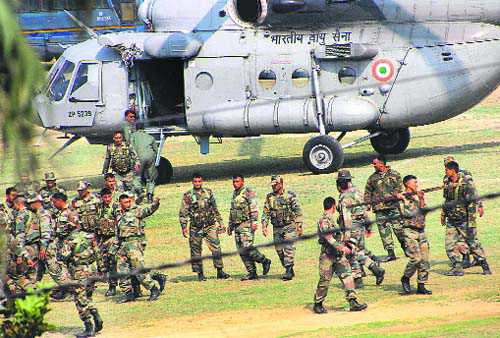
Soldiers being air-dropped at Rohtak. AFP
“Iss se to Angrezon ka raj hi accha tha” (The British rule was better than what we see now), said an old soldier from Haryana the other day. Having born, brought up and educated in a much bigger joint India, At the age of 21, I, like lakhs of others, bid a forced goodbye to my home and shifted to a truncated India at 21 years after Partition. I loved staying in erstwhile India, which was very peaceful till the time the maverick politicians did not sow the seeds of dissention and religious divide among gullible people. Consequent to Khattar’s announcement in Rohtak on February 15, that the government would wait till March 31 for the report of the committee dealing with the Jat reservation, the latter became restive and started blocking roads and carrying out protest marches. The non-Jats resented this and began anti-reservation marches, resulting in clashes between Jats and non-Jat groups. This was followed by burning of shops, houses, vehicles, business establishments and offices. Shamefully, on February 22 at Murthal on NH 10, women were forcibly pulled out of cars by goons, dragged to the fields and gangraped. Their cars were burnt, their husbands were looted and beaten up. There was a discernible division between the ministers and bureaucrats on the basis of caste. This resulted in the collapse of the state machinery. The Haryana police failed to grapple with the worsening situation. At best, some of them acted as a shield between the clashing groups. The rest stood as if nothing had happened. On February 18, rioting took an ugly turn in Rohtak when the rival protesting groups clashed and threw stones at each other and the police. After that, the BSF troops were deployed. On February 19, the protesters clashed with the police and the BSF personnel. Three persons were killed and more than 100 injured when the security forces opened fire to control the rioters. The police personnel vanished from the scene of violence and even abandoned their posts on February 20. The Army was airdropped at Rohtak on the same day. The Army carried out a flag march in Rohtak on February 20. The violence by now had spread to several towns in Haryana. After the Army was deployed in parts of Hisar on February 22 and despite the curfew, armed mobs looted, ransacked and burnt down at least 20 houses at village Dhani Pal. The policemen and an Army column, as per the media reports, failed to control the mob. According to the rule book, law and order is a state subject, it should be controlled by the state police in conjunction with the state armed police. When the situation goes out of the hands of the police, the paramilitary forces are called in, If they too blink, then the Amy, which is government’s last resort, is called in to restore order. Soon after their deployment on this duty, both police and paramilitary forces start looking over their shoulders for the Army to come and control the situation. Because of this mindset, they do not take the situation seriously. If commanders of these forces are taken to task for dereliction of duty (as it happens in the Army), they will willy-nilly accomplish their task. Displaying the might of the Army had a catalytic effect on the civil population during the British regime because it was kept away from the people. Its sudden appearance on he scene did, therefore, ring a warning bell in the minds of the trouble makers. The flag marches by the Army have become very common. That is why they have lost their effect these days, thanks to the deteriorating law and order situation in the country. These marches are undertaken by the Army when it comes on the scene to create a deterrent in the minds of undesirable elements and to restore confidence among the peace-loving citizens. But unfortunately, the flag marche achieve none of these objectives. On the contrary, these marches can do more harm than good as the marching or mounted columns present a good target to the trained and well-equipped trouble makers. Given the current situation in the country, every move by the troops in the disturbed areas should be tactical and not ceremonial.After the deployment of the Army in Haryana on February 20, there was hardy any media coverage about it. This was unusual as the Army always comes in for praise whenever it is deployed to quell disturbances. The only mention about it was that “the Army column (in Hisar) failed to control the mob.” There was a whisper in certain quarters that, like the police, the Army also gave a short shrift to law and order in Haryana. Accountability has become the worst casualty in modern India. It is a free-for-all situation and you can get away even after committing a heinous crime, provided you have tonnes of money and /or political support. Ironically, the hedge has started eating the crop. It has become a fashion to wear religion and caste on one’s sleeves and brag about it loudly. Surprisingly, all our problems stem from indecision of the politicians. This reminds one of what William James said: “There is no more miserable human being than one in whom nothing is habitual but indecision”. Who will stem the rot?The writer, a retired Colonel, is a defence columnist.
